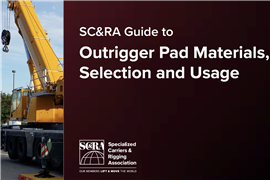Irish heights: McNally's Crane Hire expands into access
20 November 2008

It seems like a big move for any company, much less for a relatively small crane rental company in Ireland. Going from no aerial platforms at all to owning the world's biggest, in one fell swoop, is a big jump, for anyone.
However, company director Cathal McNally is rather matter-of-fact about the decision to spend somewhere in the range of €1.500 million for the Wumag Elevant WT 1000, due to join his fleet by December. He explains the purchase in simple, compelling business terms: "Basically we have been forced into it. It is a demand from the customers we have."
The demand for a better high access capability is from wind turbine work, work that appears to be booming generally as power companies develop alternative energy sources.
McNallys is certainly used to heights. It has been working on wind turbines since 1998, using cranes to lift components and, when required, to provide access.
The WT 1000 will be an alternative to swing baskets, which McNallys uses "...when no other option is available. Some of our cranes have a maximum jib height of 180 m. A swing stage naturally swings, sometimes a lot. We really don't want the work platform moving while they work," says Mr Mc Nally.
"We have two men in the basket, and two more men on the ground on ropes holding it. It's sometimes hard to get a fixed point on the ground [for the ropes that stabilise the basket].
"Our success is due to our people. They don't mind working on the cold, wet side of a mountain, but swinging about in a basket is a different story."
Ensuring crew safety and maximising their efficiency is important to McNally's, but the risk is not only to the men. "We have been putting tyres and foam on the basket to protect the turbine from bumps and scrapes. We have even made baskets and fitted them to the crane boom, fixed to the jib head," says Mr Mc Nally, who shares leaderships of the company with his brother, Hugh.
"We need to move all over the turbines, and using swing baskets is just not efficient. Baskets are going to be banned; it's as simple as that," he says.
Site accessibility was clearly an important consideration in choosing the Wumag. "Its chassis will go everywhere. That's important to us. Wind turbines are never just on the side of the road.
"Getting to the site is the main problem. Moving heavy equipment on soft, floating roads is a nightmare. We need an all-terrain platform, and the Wumag machine is perfect."
The company is used to having big, tall pieces of equipment around; Mr Mc describes its 30-odd crane fleet as "top heavy". Biggest is a recently-delivered 500 t Terex-Demag TC 2800-1 all-terrain crane, on eight axles. (The WT 100 has five.) So the world's largest access platform will look right at home in its depots and on-site, especially because it, too, has an all-terrain crane chassis.
The company's first wind turbine work was for power company Vestas in Cork, Ireland, and it has since completed projects in France, Spain, the UK, Norway, Italy, Australia, and the Falkland Islands. Today the company has five crews installing turbines.
McNallys formed the company Windhoist in 1998, to focus on wind turbine work. Based in Irvine, Scotland, it does some wind turbine maintenance now. Mr Mc Nally thinks that side of the business will grow as the number of turbines in service grows. "Most wind farm operators take a five- to ten-year warranty [on the turbines]. We hope to offer a cleaning, inspection, and reporting service. We plan to give fixed price service," he says.
A high-working height, large out reach, manoeuvrable access platform fits right into McNallys' wind turbine maintenance plans. It will use the Wumag "...mainly in the UK, but we will send it anywhere we get work, anywhere, if the job is right."
Given that most wind turbines have far less than 100 m hub height, you might question the decision to buy 103 m of working height. Mr Mc Nally says, "...60 m would be our typical work height, but plenty [of hub heights] in Europe are 100 m plus. It is good to have the flexibility...we want to have the capacity."
Was choosing the Wumag a long process? Apparently not. Mr Mc Nally tells AI, " I walked around at Bauma last year and visited all the manufacturers of big platforms." He listened to sales presentations back in Ireland, and made the decision to buy Wumag through its UK distributor, Skyking, in Leicestershire, in less than two weeks.
"We decided to go for the whole lot, to get as much capacity as we can. In this business, if you've got the biggest, you'll likely get the call, he says. Mr Mc Nally also appreciates market forces, saying; "The bigger the machine, the bigger the bucks."
Despite soon to own the world's biggest, Mr Mc Nally says, "...we're not an access company. We are basically testing the water."
The company has two depots in Ireland, the main one in Dublin and the company's original depot in Monaghan. Its Far Eastern operations are out of a rented facility in Portland, Australia, and the current search for a purchased base signals the company's long-term aspirations there.
Why in a region so far away from home? "Wind turbine work is a growing need at the moment," says Mr Mc Nally. If Ireland and the UK slow down, we will more actively pursue the business in Australia. In Europe, every crane company is gearing up for wind turbine work.
"Our service in Australia is quite unique at the moment. We are the first to offer both the equipment and the personnel to erect turbines."
But more than just the opportunity there and a common language that drives his interest. Mr McNally expresses a sentiment that helps you understand the decision to bear the expense of the world's biggest aerial platform and to take the plunge into wind turbine maintenance.
"Why in Australia? Because we're Irish. Everybody in Australia said, "Those Irish, English, and German companies come here and fail." Well, we're an Irish company. We can do it."
That is the kind of spirit that explains the jump from having none to the world's biggest of aerial platforms, and the spirit that is likely to make it a success.


